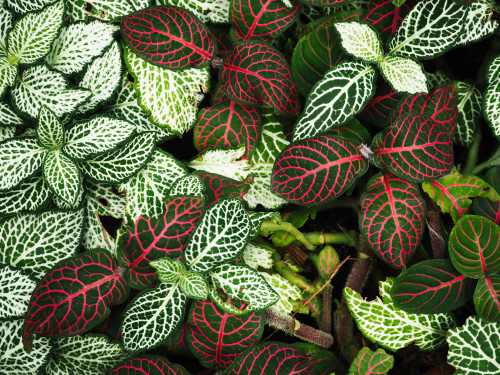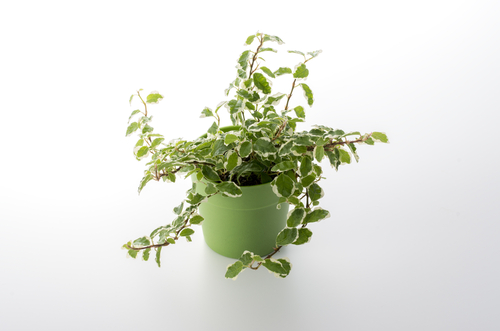Countryside Corner
Neighborly Garden News

Issue 117
January 2022
Dear readers; please visit our website: www.countrysidelandscape.net for the safety measures we have in place during this pandemic.
Try growing a terrarium this winter!
As I write this, its snowing, and I’m already missing my outdoor garden. Growing houseplants helps make up for not gardening outdoors during winter. It’s a longstanding hobby of mine, and I’m always looking to share new ideas. Creating a terrarium garden, a containerized miniature world, can be a fun winter gardening project for beginners or advanced indoor gardeners. A terrarium is an indoor gardening container, usually made of glass that is fully or partially enclosed to allow heat and light to enter and conserve moisture. The word “terrarium” is comprised of the Latin words “terra” (earth) and “arium” (place, or receptacle).

Finished terrarium in a Mason jar
You can use almost any large glass container: mason jars, goldfish bowls even a glass cookie jar. When considering terrarium plants, look for slow-growing plants that thrive in low to medium light, and are tolerant of high humidity. Succulents and cacti species are not good candidates for a terrarium, because they require drier conditions. Minature ferns, nerve plant (fittonia spp) polka-dot plant (hypoestes) creeping fig (ficus pumila) are all very adaptable to terrarium life and have great foliage too. Moss is a good choice for terrarium culture; it thrives in low light and high humidity. Sheet moss, (Hynum and Ptilium spp) resemble tiny ferns, while pincushion and rock crop moss (Leucobryum and Dicranum spp) look like miniature Pine trees.
Pin cushion moss

Fittonia plants in different colors

Variegated creeping fig is a good candidate for the terrarium
You will need to assemble your tools and materials. Use a narrow funnel, available in auto stores to add soil and gravel without spilling. You can also use a long handled serving spoon. If the container opening is too small for your hand, you may find having long-handled tongs helpful in positioning plants. You will need aquarium gravel, it can be natural or colored, activated charcoal, sheet moss or construction paper cut to the size of the container, and sterile potting mix without any fertilizer mixed into it. (Some potting mix is sold with timed-release fertilizer already in it).
Begin by placing a 2 inch layer of gravel on the bottom of the container; a tall and narrow container will need slightly more gravel (about an extra inch) for better drainage. Place a piece of the construction paper, or use the sheet moss on top of the gravel and using the narrow funnel or your large spoon add ½ inch of the activated charcoal on top of the moss or paper. The paper or moss acts to prevent the mixing of the loose materials keeping the layers neat and clean looking from the outside of your container. Add another layer of paper or moss, than using your spoon or funnel add 2-3 inches of potting soil. Be sure there is enough ‘headroom’ for your plants to grow without touching the top of the container.
Think about how you will place your plants, and create some dips in your indoor world to create contours in the inside terrain. As you remove your plants for their nursery pots, inspect their roots. You may need to untangle any of those that have become densely pot-bound, and root-prune them as needed in order to fit them in their new home. Root-pruning also helps to slow down the plants growth, so don’t hesitate to do this. Be sure to trim off any roots that are brown or discolored. Also remove any broken or yellowing leaves. You may also want to add decorative pebbles or shells, even a tiny figurine for a bit of fun.
After you’ve planted each plant, be sure to tamp each one down lightly to remove any air pockets. Watering is made easier and with less disturbance if you use a spray mister, or have a small watering can with a long spout and a water diffuser to eliminate splashing. Water the new terrarium so that your plants are damp, not soaking wet. Terrariums do their best when exposed to bright indirect light. Direct sun exposure will make it too hot and steamy inside the container, and potentially ‘cook’ your plants. If you don’t have a place with this exposure, artificial light, such as an LED or florescent, will give them all the light they need without any of the heat.
To maintain your terrarium every three weeks do these steps: Feel the soil to see if it’s dry and needs water. Partially and fully enclosed terrariums retain water considerably longer than most potted houseplants. Inspect a closed terrarium for condensation. Take off the top at least once a month to increase airflow. Leave the top off until the condensation disappears. Also, take off the terrarium top if you added too much water. Remove yellowing or damaged leaves and prune plants to a smaller size if they’re growing too large for the container.
Never fertilize the plants in a terrarium. Terrariums provide their own nutrients through the natural decay of the potting mix. Have fun creating a containerized mini-garden!
January’s ‘to-do’ list
As I sit to write the first newsletter of the New Year, there is still no snow on the ground here in the valley. We have seen a few flakes, but nothing else. When I visited Williamstown recently, I wasn’t surprised to see upwards of six inches of snow in Savoy and Florida, MA, close to the highest elevations in the state. It does feel strange not to have had a killing frost until well into November. According to the Climate System Research Center, at UMASS Amherst; Massachusetts has had the third warmest autumn on record. Additionally, four of the five warmest autumns on record have occurred during the past 11 years. I’m left to wonder what will this winter bring in terms of weather and precipitation. My best advice; be prepared for anything!
Winter is the preferred time for annual maintenance of fruit trees; pruning, thinning, and shaping, promotes a healthier tree. Most fruiting trees have a very vigorous nature and will grow quickly. Pruning helps channel that energy into fruit production, by eliminating extraneous twiggy growth, and poorly shaped branches. Dormant trees are easier to work on, a good project for a sunny winter’s day. If you need help or advice, please contact our office.
info@countrysidelandscape.net or phone 413.458.5586
While your garden is dormant, plan for corrections to the major elements of the space and address any drainage problems. Take a critical look at the garden structure. Is there enough shade where you need it, or too much where you don’t? Are there low spots that always stay wet after heavy rains, have you had any washouts causing erosion of the soil? Consider, too, the time and labor of staking tall perennials, what can be substituted to conserve your time and efforts?
This bears repeating:during freeze and thaw cycles, be careful not to walk on your garden beds when they are wet and muddy during a thaw, it canpermanently compress the soil structure. Check for any plants that may have ‘heaved’ out of their planting holes during freeze/thaw cycles. Gently push them back into place.
I recently listened to a birding podcast, and the caller wanted to attract birds to their yard, but didn’t want to be troubled by having any feeders around to attract squirrels. I’m going to be diplomatic, and say that despite the squirrel’s ravenous nature, they do deserve to be fed during the winter also. The Podcaster recommended planting fruit-bearing trees and shrubs as a supplement winter food source. Some of our most ornamental plants do produce fruit that birds will relish. Some great examples are native Winterberry Holly, native Staghorn Sumac, and Crabapples that produce fruit (some cultivars are sterile). Oak trees, too, are one of the top trees for attracting wildlife in the Northeast. Make plans, over this winter, for establishing and planting a haven for birds next season. In the meanwhile, do provide for our feathered and furry friends; extra food and water can literally save a life.
Have you started to receive those gorgeous seed and plant catalogs yet? Yes I still get snail mail, but I typically order online these days. Nothing like a beautifully styled plant photo to get your gardening juices flowing…To ensure your first choice, it’s really helpful to get your orders in early. Some items really do sell out quickly. If you’re looking for a certain specific plant, or cultivar, sometimes the only way to buy it is through a specialized nursery. Local independent garden centers may have a more varied selection, than a big box store; and they sometimes can do a special order for you, if you’re not able to grow your own.
Once we receive consistent snow cover, browsing animals will be looking for available food. Animal repellent sprays can be applied as needed throughout the season. You can achieve good results if you are consistent with applications. It may be helpful to rotate repellent products so tolerance to the taste/smell doesn’t develop. Deer, rabbits and voles seem to have their favored feeding routes, and will keep returning unless you deter them.
Enjoy the break from the labor of love that encompasses caring for the outdoor garden. Take a gardening class with the Berkshire Botanic Garden https://www.berkshirebotanical.org/eventsVisit a local greenhouse and feel a breath of warm air and plant life at The Lyman Plant House at Smith Collegehttps://garden.smith.edu/visit or the Durfee Conservatory at University of Massachusetts at Amhersthttps://durfeeconservatory.umass.edu/ Sometimes seeing some green growing plants is a big pick-me-up from the winter doldrums! (check before going as to the ongoing schedule changes brought about by the pandemic).
Bees escape sure death; a sign of their resiliency
I read some very uplifting news recently, in the NY Times. After the devastating eruption of the Cumbre Vieja volcano in La Palma, part of the Canary Islands last September; which destroyed whole villages with flows of burning lava, a beekeeper returned to his village to see what remained. Fifty days after the eruption he found five beehives buried under volcanic ash still very much alive. Inside each hive were tens of thousands of buzzing bees.
It is truly remarkable that the bees survived through intolerable conditions; extreme heat, noxious gas, and the suffocating ash, in addition to starvation. The bees were able to seal themselves inside the hive by producing a resin-like substance called propolis. This substance is something bees make from plants, and use to help patch holes in the hive and keep out the rain, explained Nathalie Steinhauer; researcher at department of Entomology at the University of Maryland. Sealing themselves inside the hive protected them from the poisonous gas; they even created an exit route for future escape. Starvation was avoided by rationing the stores of honey in each hive. All these behaviors are typical of honeybees.
Reading about this amazing success story drives home about how tough a creature the bee is. Resilience is a characteristic inherent in this insect; see how long they have survived on earth despite all the real threats to their existence: loss of habitat, pests and diseases, and pesticide use. Still the fact that the bees on La Palma managed to spend weeks inside their hives, insulating themselves from such oppressive conditions was surprising and inspirational, Dr. Steinhauer said.
The honeybee local to this area is called the Canary black bee. Honeybees are not considered an endangered species, but bees are considered vital to this local eco-system, and support the farmers who sell the honey. Later, hundreds of other living hives were discovered in La Palma, after the eruption, and were able to be saved. The bees were very lucky to have survived partly due to the light and porous nature of the volcanic ash; it allowed for oxygen to pass through. The honeybees can’t return to the original villages because most of the local vegetation has been swallowed by the lava and ash. The surviving hives were relocated to other parts of the island, not in the path of the lava flows.
Donate to La Palma relief fund here: https://www.globalgiving.org/projects/la-palma-volcano-relief-fund/
Thinking ahead…
If you’re a birding enthusiast, and actively seek out bird watching opportunities, or just a bird and animal lover, planting a few fruit bearing plants will boost the visitors to your yard. Fortunately there is a wide variety of native shrubs that our local birds and other wildlife will flock to. It is important to include species that will hold their bounty of fruit through our long winter, to provide a food source through lean times.
Aronia arbutifolia-‘Brilliantissima’ Native Red Chokeberry produces very tart and bitter fruit, which only become edible after several freeze/thaw cycles. This makes them a good shrub for providing food during late winter. It is highly adaptable to various sun exposures (full sun, part sun, partial shade) and soil types. It likes wet, boggy soil, and will grow well along stream banks, its spreading/suckering growth habit will help with erosion control. Grows 6-8 ft tall x 6-8 ft wide.

Red Chokecherry with fruit
Parthenocissus qinquefolia-Native Virginia Creeper produces dark blue fruit with an exceptionally high fat content. Higher fat content fruit provides a good source of energy for our local birds. Planting native shrubs ensures that the birds will recognize the fruit as a known food source, and not spend less time (and energy) foraging. Virginia Creeper is a vigorous vine that does not require support once established as it will adhere to many surfaces with their own holdfasts. Grows 30-50 ft tall and likes full to partial sun exposures.

Virginia Creeper with fruit
Myrica pennsylvanica-Native Northern Bayberry is another shrub that produces very high fat content fruit. The fragrant waxy berries have long been used in candle making. The shrub is considered semi-evergreen, so may hold their leaves through early winter before dropping them. Bayberry will attract Chickadees, Cedar Wax-wings, Woodpeckers, and Eastern Bluebirds. Bayberries prefer full-part sun, and will grow 9 ft tall x 9 ft wide.

Northern Bayberry fruit
Viburnum dentatum-Native Arrowwood Viburnum is a very ornamental species; producing hundreds of flat topped white flower clusters in the spring, followed by dark blue fruit in late summer. The fruit persists through winter. Robins, Vireos, Thrush, Juncos and Cardinals will seek out and feed from the Arrowwood Viburnum. There are also quite a few cultivars available that will vary in their mature size: ‘Blue Muffin’ will stay compact 5-7 ft tall, Chicago Lustre will grow taller 10-15 ft tall x 10-15 ft wide. Prefers full to partial sun exposure.

Arrowwood Viburnum with fruit
Ilex verticillata-Native Winterberry Holly is a terrific shrub for wet and boggy areas. It is easy to find it locally growing at the edges of streams and ponds. I often seek it out when doing my holiday decorating. Winterberry Holly will hold its fruit through winter, and provide sustenance for Grouse, Quail, Blue jays and Eastern Bluebirds. It is important to obtain at least one male plant to ensure pollination for a good fruit set, as these shrubs have separate male and female flowers. Cultivars have been developed with orange or yellow fruit, in addition to the red fruiting variety. Winterberry Holly requires consistently moist soil, and full to partial sun exposure. Depending on the cultivar, grows 3-8 ft tall x 3-8 ft wide at maturity.

Winterberry Holly with fruit
